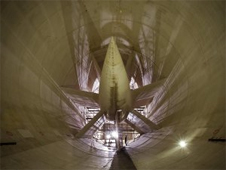January 29, 2010 Vol. 3, Issue 1
Is the aerospace industrys ability to innovate broken? Aviation Week investigated and found that there is a need for a new perspective on innovation.
Last summer, when Aviation Week convened 70 leaders in the aviation industry to discuss the challenges facing their community, innovation emerged as the biggest concern. Aviation Week and Charles River Associates (CRA) then conducted a study that included an extensive literature review and more than 30 interviews. Aviation Week & Space Technology published the studys findings in its October 26, 2009 issue.

Facility manager inspects the fan blade area of the 14 x 22 Foot Subsonic Tunnel at Langley Research Center. Photo Credit: NASA/Sean Smith
Their conclusion: the aerospace industry hasnt lost its ability to innovate. Rather, it has lost sight of how innovation has changed since the middle of the 20th century. To foster discussion on the topic, Aviation Week held a webinar on December 8, 2009, featuring speakers Nan Mattai, Senior Vice President of Engineering and Technology at Rockwell Collins; Anthony L. Velocci Jr., Editor-in-Chief of Aviation Week & Space Technology; Ben Doeckel, Research Lead and Director of Charles River Associates; and Mike Adami-Sampson, Vice President of Product Strategy for Aerospace and Defense Solutions of Dassault Systeme.
The industry is moving from product innovation (higher, faster, farther) to process innovation (better, faster, cheaper), reported Doeckel. The industry is not in the middle of a crisis, just in the middle of change. “Innovation is much more complex than we think or wish it might be,” Doeckel added. The industry is discovering the change in the type of innovation that is taking place today.
Attracting young innovators is another challenge to overcome, Velocci noted. The late 1990s and early 21st century saw major cuts in industry jobs, and the aerospace and defense workforce is aging, with fully one-quarter ready to retire within the next five years. Young talent is also being lured to other industries. The industry must be more creative in attracting talent and improving public perceptions of the aerospace and defense industry.
To accomplish this, the industry needs to bolster the industry pipeline with STEM education, encourage cultural diversity, and recruit more women and minorities, according to Mattai. Increasing global collaboration and partnerships among government, industry, and academia is also essential.
Without aerospace innovation, remarked Adami-Sampson, only the birds, bats, and insects would fly. “Innovation is like a latent seed in the heads of employees,” he said. The key lies in understanding the new perspective on aerospace innovation.
Aviation Week will host an innovation forum intended to build a community of young and experienced innovators in February. Their next innovation roundtable will take place in March.





